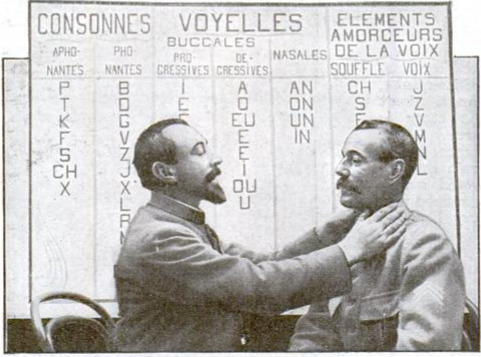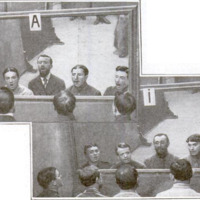Method developed by two French doctors aiming to treat the victims of shell shock
Item
-
Title (Dublin Core)
-
Method developed by two French doctors aiming to treat the victims of shell shock
-
Article Title and/or Image Caption (Dublin Core)
-
Title: Making the Dumb to Speak
-
Subtitle: The latest methods of specialists in treating victims of shell shock
-
extracted text (Extract Text)
-
COMPLETE loss of speech was one
of the serious results that devel-
oped in many soldiers suffering
from shell shock. It afflicted most
frequently men whom the hor-
rors of the Great War had
brought to a state of nervous
tension which predisposed them
to this particular pathological
condition. Drs. G. Liebaut and
E. Coissard, two eminent French
nerve specialists, studied the
disease, and organized a clinic
for restoring to these soldiers
the power of speech in ac-
cordance with the methods
employed in schools for the
treatment of deaf-mutes.
Among the patients in that
clinic there are none who have
lost their ability to speak
through any physical injury of
the organs of speech. Nearly
all of those who undergo treat-
ment are eventually cured or at
least greatly improved: by a
‘systematic training of the organs
of speech, which include the lungs, the
larynx, the pharynx, the mouth, |
nose, and lips.
Careful Examination of Each Patient
Before beginning treatment the doc- |
tors carefully examine each patient
to ascertain his lung capacity, method |
of breathing, and any abnormal pecu-
liarities in the mechanism of drawing |
in and expelling air. The lung is
measured by a simple yet accu-
rate apparatus devised by Dr.
Coissard. The apparatus is con-
structed like a gasometer. A
cylindrical tank is filled with water.
‘Within that tank, but closed at the
top, is a smaller cylindrical con-
tainer, held in position by coun-
ter-weights connected with it by
cords running over pulleys.
The air exhaled by the patient
is conducted by a tube into the
floating cylinder, and, by displac-
ing the water contained in it,
causes the inverted container to
rise. A scale on the side of the
tank indicates the volume of air
exhaled. The chest expansion is
measured with a tape-measure,
and the movements of the dia-
phragm are recorded by two radio-
graphs taken of the extreme posi-
tions of elevation and depression
during the process of breathing.
The force of exhalation is measured
by a pulsometer, and the time of
inhalation and exhalation by a stop-
watch. Then the functioning of the
larynx, lips, and other speech organs
is carefully observed and noted.
Each case is studied individually
by the doctors. After a thorough
consideration of the facts in each case,
the method of treatment best suited
to the condition of the patient is
determined.
Breathing exercises are given first,
to correct any defects developed by the
nervous affection of the patients in
their respiration. These exercises are
supported by gymnastics of the arms.
and body. |
To restore the normal functions of
the vocal cords is far more difficult.
After the patient has been taught to
breathe properly, his throat is massaged
by hand or by an electrical vibra-
tor. By slow degrees the shell-
shock victim is taught to emit
sound at the time of exhaling.
First the Vowels
The patient begins with the
vowel 0. If he does not succeed
in emitting the simple sound,
his throat is gently manipu-
lated by the doctor, who de-
presses the larynx of the patient
with his fingers to stimulate and
assist that organ in the effort
of resumingitsnormal functions.
These exercises can be taken
for only a brief time each day.
After the patient has learned
to pronounce the vowel o with-
out assistance, he begins to
learn how to pronounce the
vowel e, which in French
is pronounced like “ay” in the
English word “bay.” Then follow
in the same order the vowel sounds |
eu, ou, u, a, and i as pronounced |
in French.
The last phase of the treatment
includes the careful and systematic |
training of the muscles of the cheeks, |
tongue, lips, pharynx, and nose which
present symptoms of paralysis. These
exercises are performed by the patients
in front of a mirror.
After they have learned
to respond in an almost
normal manner, the patients
essay the pronunciation of
simple combinations of vow-
els and consonants.
In most of these cases
speech is restored in a few
months.
-
Contributor (Dublin Core)
-
Lucien Fournier (Image copyright)
-
Language (Dublin Core)
-
eng
-
Date Issued (Dublin Core)
-
1919-05
-
pages (Bibliographic Ontology)
-
24
-
Rights (Dublin Core)
-
Public domain (Google digitized)
-
Archived by (Dublin Core)
-
Davide Donà
-
Marco Bortolami (editor)
 Popular Science Monthly, v. 94, n. 5, 1919
Popular Science Monthly, v. 94, n. 5, 1919




